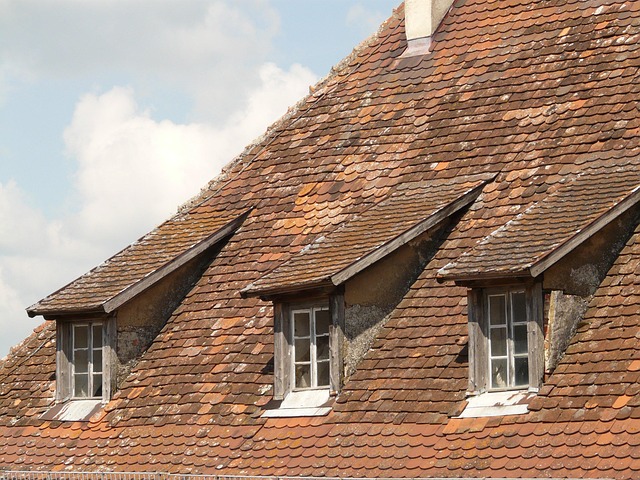The traditional roofing industry poses significant environmental challenges but a growing demand for sustainable roofing solutions is driving change. Eco-friendly alternatives like recycled metal, clay tiles, and solar reflective shingles reduce waste, minimize energy consumption, and lower carbon footprints throughout their lifecycle. These options enhance indoor air quality, improve insulation, save energy, have longer lifespans, and resist harsh weather conditions. Reflective or "cool" roofs help mitigate the urban heat island effect while green roofing systems support better watershed management and reduce noise pollution. Regular maintenance using eco-friendly methods ensures these sustainable solutions remain effective for years to come.
In today’s eco-conscious world, the impact of traditional roofing materials on our environment cannot be overlooked. This article explores the rise of environmentally friendly roofing services, offering a glimpse into sustainable roofing solutions that benefit both nature and your home. We’ll delve into the negative effects of conventional practices, uncover the advantages of choosing eco-friendly materials, and present innovative technologies revolutionizing the industry. Get ready to discover how green roofing can enhance efficiency and longevity while minimizing environmental impact.
- Understanding the Impact of Traditional Roofing on the Environment
- The Benefits of Choosing Sustainable Roofing Materials
- Innovative Technologies in Eco-Friendly Roof Installation and Maintenance
- How to Ensure Longevity and Efficiency with Green Roofing Practices
Understanding the Impact of Traditional Roofing on the Environment
The traditional roofing industry has long been associated with significant environmental impacts, from the extraction of raw materials to the manufacturing processes and eventual disposal. Many conventional roofing materials, such as asphalt shingles, contribute to a substantial amount of waste ending up in landfills due to their limited lifespan and lack of recyclability. Additionally, the production of these materials often relies on energy-intensive methods, leading to increased greenhouse gas emissions and further environmental strain.
As awareness of ecological issues grows, there is a growing demand for sustainable roofing solutions. Environmentally friendly roofing services offer an alternative that minimizes these negative effects. These services focus on using eco-conscious materials like recycled metal, clay tiles, or solar reflective shingles, which not only reduce waste but also lower energy consumption and carbon footprints during installation and over the roof’s lifetime.
The Benefits of Choosing Sustainable Roofing Materials
Choosing sustainable roofing materials offers a multitude of benefits, both for your home and the environment. These eco-friendly options reduce the carbon footprint associated with traditional roofing by utilizing recycled or renewable resources, minimizing waste, and lowering energy consumption during manufacturing. Sustainable roofing solutions also contribute to improved indoor air quality due to their lack of harmful chemicals and better insulation properties, leading to more energy-efficient homes.
Furthermore, sustainable roofing materials often come with longer lifespans, ensuring long-term savings for homeowners. They can withstand harsh weather conditions, reduce noise pollution, and provide unique aesthetic appeal. By opting for these environmentally friendly roofing services, you’re not just making a responsible choice but also investing in a durable, healthy, and visually appealing living space.
Innovative Technologies in Eco-Friendly Roof Installation and Maintenance
The world of roofing has seen a significant shift towards eco-conscious practices, thanks to the emergence of innovative technologies in sustainable roofing solutions. These advanced methods offer an array of benefits, from enhanced energy efficiency to reduced environmental impact. One such game-changer is the use of reflective or cool roofs, designed to reflect sunlight instead of absorbing it, thereby lowering building temperatures and decreasing the urban heat island effect.
Another notable trend is the integration of green roofing systems, which involve planting vegetation on rooftops. This not only adds a touch of nature to urban landscapes but also provides insulation, reduces noise pollution, and absorbs rainwater, contributing to better watershed management. Regular maintenance plays a crucial role in ensuring these eco-friendly roofs remain effective. Services offer specialized care, including sustainable cleaning methods, regular inspections for damage or wear, and prompt repairs, all while minimizing the use of harmful chemicals and promoting the longevity of these green solutions.
How to Ensure Longevity and Efficiency with Green Roofing Practices
To ensure longevity and efficiency with green roofing practices, it’s essential to start with high-quality materials that are both environmentally friendly and durable. Sustainable roofing solutions often incorporate components like recycled content, energy-efficient insulation, and water-resistant membranes. These materials not only reduce the environmental impact but also stand up better to extreme weather conditions, extending the roof’s lifespan.
Regular maintenance is another key factor. Green roofs require specific care to keep their systems optimized. This includes routine inspections, cleaning to prevent debris buildup, and ensuring proper drainage to avoid water damage. By maintaining your green roof effectively, you can maximize its energy efficiency, reduce waste, and ensure it remains a vibrant and functional part of your property for years to come.
In light of the environmental impact of traditional roofing practices, embracing sustainable roofing solutions is a responsible step towards a greener future. By choosing eco-friendly materials and innovative installation methods, homeowners and businesses can contribute to reducing their carbon footprint. Green roofing not only minimizes waste but also offers long-term benefits such as energy efficiency and extended roof lifespans. Adopting these environmentally friendly practices is key to navigating the roofing industry’s metamorphosis towards a more sustainable landscape.
